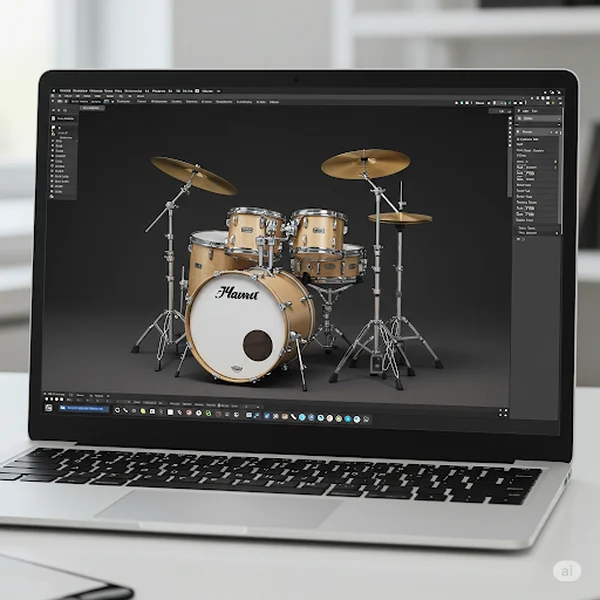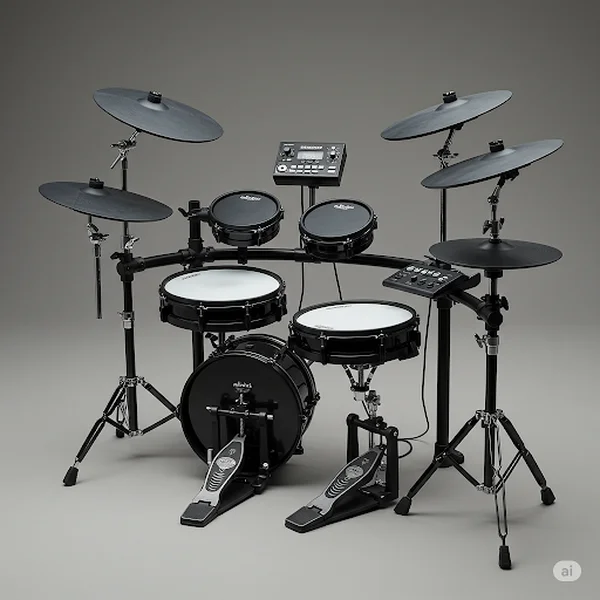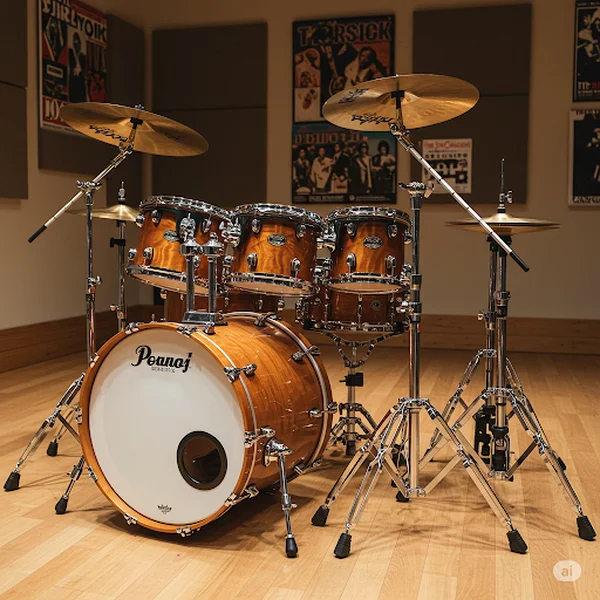Virtual vs. Electronic vs. Acoustic Drums: Best Choice for You?
Choosing your first drum set can be exciting yet overwhelming. With options ranging from traditional acoustic kits to modern electronic and innovative virtual drums, how do you decide which path will lead you to your perfect beat? This guide will compare virtual drums, electronic drums, and acoustic drums, helping you understand their differences and decide which is the best choice for your drumming journey.
Understanding the Contenders: Virtual, Electronic, and Acoustic Drums Explained
Before we dive into a detailed comparison, let's get familiar with each type of drum set.
What are Virtual Drums?
Virtual drums, like those you can find by exploring online drum simulators, are software-based instruments that emulate a real drum kit. You play them using your computer's keyboard, mouse, or even a touchscreen. These platforms often provide high-fidelity drum sounds in real-time, offering a surprisingly realistic drumming experience. Their main appeal lies in accessibility, affordability, and the ability to practice silently with headphones. They are perfect for practice, entertainment, and even basic music creation, all through a simple and portable interface.

Exploring Electronic Drum Kits
Electronic drum kits feature physical pads and cymbals that you strike with drumsticks, similar to an acoustic set. However, instead of producing sound acoustically, these pads trigger pre-recorded or synthesized drum sounds through an electronic "brain" or module. You typically listen through headphones or an amplifier. Electronic drums offer a wide varietyalty of sounds, built-in metronomes, practice tools, and are significantly quieter than acoustic drums.

The Classic Acoustic Drum Set
Acoustic drum sets are what most people picture when they think of drums. They consist of wooden shells with drumheads, metal cymbals, and hardware. When you strike an acoustic drum, the vibration of the drumhead and shell produces a rich, natural sound. They offer an unmatched dynamic range and playing feel but are loud, require significant space, and can be costly.

Drum Set Comparison: Key Factors to Consider
Let's break down how these three types of drums stack up against each other in crucial areas.
Analyzing Sound Quality & Authentic Feel Across Drum Types
Acoustic drums undeniably offer the most authentic sound and feel, with natural resonance and dynamic response. High-end electronic drums can come very close, with sophisticated sound engines and mesh heads that mimic acoustic feel. Virtual drums, while software-based, can offer surprisingly high-quality sound samples. The "feel" on virtual drums depends on your input method (keyboard, mouse, touch), which is different from stick-based playing but still allows for rhythmic practice and expression.
Practice Demands: Noise, Space, and Drum Portability
Noise is a major factor. Acoustic drums are extremely loud. Electronic drums are much quieter, with the main noise being the tap of sticks on pads. Virtual drums are the quietest option, as all sound is generated through your computer and can be channeled directly to headphones, making them ideal for apartments or shared living spaces.
In terms of space, acoustic kits demand the most room. Electronic kits are more compact. Virtual drums require virtually no extra space beyond your computer setup, making them incredibly portable. If you want to play drums online anywhere, virtual drums are a fantastic choice.
Drum Kit Cost & Budget Realities for Beginners
Acoustic drums, especially new ones, can be a significant investment, often ranging from several hundred to thousands of dollars. Electronic drum kits vary widely in price, with beginner models being more affordable than acoustic sets, but high-end versions can be just as expensive. Virtual drums are typically the most budget-friendly option. Many, like the tools for virtual drumming, are free or very low-cost, requiring only a computer or compatible device you likely already own.
Learning Tools & Features: Which Drums Help You Learn Faster?
Many electronic drum kits come with built-in metronomes, practice songs, and even coaching functions. Acoustic drums are more straightforward, relying on external tools or a teacher for learning aids. Virtual drum platforms often include features like visual feedback, various kit layouts, and sometimes even integrated lessons or rhythm games, offering a structured way to learn and practice.
Pros and Cons at a Glance: Virtual Drums vs. Electronic Drums vs. Acoustic Drums
Let's summarize the key advantages and disadvantages.
Benefits and Drawbacks of Virtual Drum Sets
- Pros: Extremely affordable (often free), silent practice with headphones, highly portable, requires no extra space, great for beginners to test interest, offers a fun way to experience simulated drumming.
- Cons: Playing feel differs significantly from stick-based drumming, sound quality can vary (though many offer high-fidelity sounds), may lack advanced features of dedicated electronic kits.
Strengths and Weaknesses of Electronic Drum Kits
- Pros: Quieter than acoustic drums, wide range of sounds, built-in practice tools, more compact than acoustic sets, good for recording.
- Cons: Can be expensive, feel may not perfectly replicate acoustic drums (especially on cheaper models), still requires physical space.
Advantages and Limitations of Acoustic Drums
- Pros: Most authentic sound and feel, best for developing stick technique and dynamic control, impressive stage presence.
- Cons: Very loud, requires significant space, expensive, less portable, limited sound options without re-tuning or changing heads.
Which Drum Type is the Best for You? Tailored Recommendations
The "best" drum type truly depends on your individual needs and circumstances.
Why Virtual Drums Shine for New Players & Tight Spaces
If you're an absolute beginner unsure about committing to a big purchase, live in an apartment with strict noise rules, have limited space, or are on a tight budget, virtual drums are an excellent starting point. They provide a low-risk, highly accessible way to start exploring rhythms and see if drumming is for you. You can easily experience a virtual drum set right now.

When Electronic Drums are the Smart Choice for Practice & Versatility
If you're serious about learning with sticks but need to keep noise levels down, an electronic drum kit is a great option. They offer a good balance of realistic feel (especially mid-to-high-end models) and practice-friendly features.
The Undeniable Appeal of Acoustic Drums for Feel & Performance
If you have the space, budget, and understanding neighbors (or soundproofing), and you crave the most authentic drumming experience, an acoustic drum set is unmatched, especially if your goal is to play in bands or perform live.
Making Your Choice: Find Your Rhythm with the Right Drum Set
Ultimately, choosing between virtual, electronic, and acoustic drums comes down to your personal goals, practice environment, and budget. There's no single "right" answer. For many aspiring drummers, especially those just starting or needing a quiet, low-cost, and portable solution, virtual drums offer an incredible way to dive into the world of rhythm. They remove many traditional barriers to entry and let you start playing immediately.
What are your biggest considerations when choosing a drum set? Have you tried virtual drums before? free to explore the realistic drumming experience offered on our platform to see if it’s the right fit for your beat! If you found this guide helpful, please share it with other aspiring drummers!
Your Drum Set Questions Answered
Are virtual drums effective for learning drumming fundamentals?
Yes, virtual drums can be very effective for learning basic rhythms, coordination, and timing. While the physical feel is different, the core concepts of drumming can certainly be developed, especially with platforms that offer good sound and responsiveness.
How close is the feel of electronic drums to acoustic ones?
Higher-end electronic drums with mesh heads and advanced sensor technology can get very close to the feel of acoustic drums. Budget electronic kits may feel less realistic.
What's the cheapest entry point for learning drums?
Virtual drums are generally the cheapest entry point, as many are free and utilize hardware you already own.
Realistically, how much room does an acoustic drum kit need?
You'll typically need at least a 6x6 foot area for a basic acoustic drum kit, plus room for you to sit and move comfortably.
Should beginners start with virtual drums before acoustic kits?
Starting with virtual drums can be a smart move for beginners. It allows you to gauge your interest and learn some basics without a significant financial or space commitment before potentially investing in an acoustic or electronic kit.